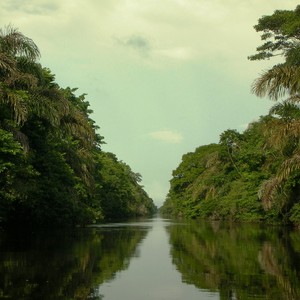I. CASE BACKGROUND
1. Abstract
The San Juan River,
as it flows in Central America, demarcates a border between Nicaragua
and Costa Rica. This border has been a source of contention between the
two states for years. The situation around the border issue is already
tense for both governments as an issue of national pride. Armed forces
have been mobilized on both sides of the border in recent years yet have
avoided armed conflict, redirecting new attention to an old dispute.
Added stresses caused by climate change, such as exteme droughts which
could cause water scarcity in the San Juan River Basin, only exacerbate
the problem. With such competition for available water resources, these
two governments may decide that armed conflict is worth the risk.
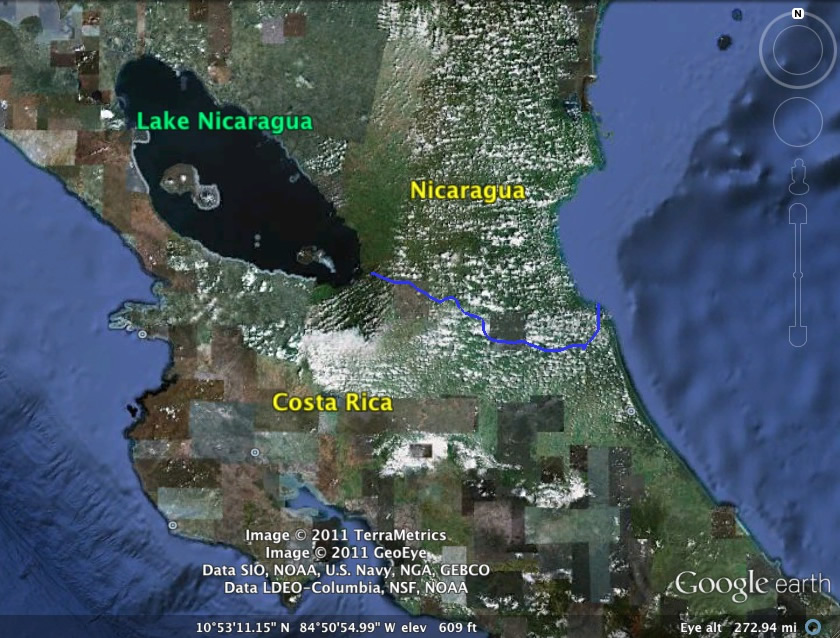
|
------- San Juan River
|
2. Description
This case study
looks at the border dispute between Nicaragua and Costa Rica over the
San Juan River. The San Juan River acts as the eastern border between
southern Nicaragua and northern Costa Rica. This border is demarcated by
the path of the San Juan River east of Lake Nicaragua. Despite the fact
that these two neighboring states have typically been friendly, this
border has not always been a source of such amiable relations. Both
Nicaragua and Costa Rica claim rights to the San Juan River, and though
they do not claim equal rights, they have never been able to fully
agree. Costa Rica claims more rights to the San Juan than Nicaragua is
willing to grant based on the 1858 Canas-Jerez treaty. This treaty made
the San Juan River the permanent border between both states. The main
tenants of the treaty stated the following: Nicaragua would "have
exclusive dominion and the highest sovereignty over the water of the San
Juan", Costa Rica would be given "perpetual rights of free navigation"
on the San Juan "for the purpose of commerce", and Nicaragua could not
enter into unilateral negotiations concerning a canal project without
consulting Costa Rica beforehand. Clearly the Canas-Jerez treaty set the
stage for opposing interpretations of rights to the San Juan River.
Nicaragua believes that it is the rightful owner of the San Juan as laid
out in the treaty yet Costa Rica also believes that it has rights to
the same water. Based upon the ambiguity of the treaty and the
disagreement between both governments, the Untied States was brought in
to arbitrate in 1888. As a result, the Canas-Jerez treaty was reaffirmed
in the Cleveland award but specified that Costa Rica's right to
navigation was onlyfor ships with cargo consisting of commercial
merchandise and did not include carrying arms. The Cleveland award did
clear up some of the ambiguity of the Canas-Jerez treaty, but did not
even begin to bring Nicaragua and Costa Rica to the same table regarding
interpretations of river rights alltogether.
Over the next 100
years or so, the San Juan River would remain a point of discontent
between both governments. In the late 19th and early 20th century, Costa
Rica would refuse to concede to canal projects which brought resentment
from the Nicaraguan government which desperately wanted a canal through
the San Juan route. Then in the 1940's Costa Rica undertook the
unilateral dredging of the Colorado River, a tributary of the San Juan
River which runs through Costa Rica. This dredging completely changed
the flow of water at the fork of the San Juan and the Colorado. Before
this decision to dredge in the Colorado, the majority of the water at
the fork of these two rivers would continue to flow to the north along
the route of the San Juan River. Today, after the dredging process, the
fork between the two rivers has shifted to widen at the mouth of the
Colorado, thus diverting more water into this tributary of the San Juan
as opposed to its natural course continuing down the San Juan River
itself. This water is now directed into Costa Rican territory and has
caused the last 37 kilometers of the San Juan River in Nicaragua to
become virtually unnavigable as it dries out and clogs with silt and
other sediment. This drying of the San Juan River has caused it to shift
northward further and further into Nicaraguan territory. Since the
officially demarcated border is the flow of the San Juan River,
Nicaragua is not only losing a valuable water resource, but is also
effectively losing territory to Costa Rica as an effect of its
unilateral dredging.
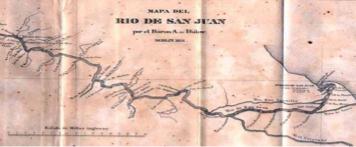 |
The fork of the San Juan River and the Colorado River in the 19th century, pre-dredge.
Water is flowing on its natural course down the San Juan River. |
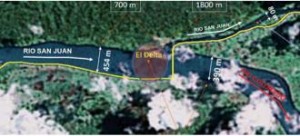 |
The fork of the San Juan River and the Colorado River in the 20th century, post-dredge.
Water is being diverted from the natural flow of the San Juan River into the Colorado River. |
Beginning in 2010,
Nicaragua set on its own path to dredge the San Juan River in order to
restore the flow of water back to its original course and regain its
water and its land. The Costa Rican government has openly opposed the
dredging, which is conveniently ignoring the fact that they did
essentially the same thing 60 years prior. Costa Rica claims that it has
concerns about the potential environmental impacts of the dredging,
especially since a large portion of the Colorado River runs through
Barra del Colorado national wildlife refuge. They claim that the
wildlife here, which has now become accustomed to and dependent on the
increased waterflow would be adversely affected. The Nicaraguan dredging
project, known as the Sovereignty, was temporarily halted due to
political pressures but has since been restarted and gained Nicaraguan
military backing. In October 2010, this dredging project nearly brought
the border dispute to blows in armed conflict. Nicaraguan troops were
seen, via aerial photographs, to be occupying Isla Calero as a part of
the dredging project which is considered to be Costa Rican national
territory.
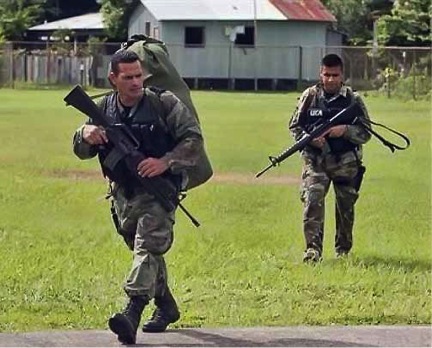
In
response, Costa Rica sent in its police force, La Fuerza Publica, to the
town of Barra del Colorado in the northeastern corner of Costa Rica,
which is the closest town to Isla Calero. Costa Rica lacks an official
army and often cites this fact as a reason to use diplomatic means in
solving its disputes and often portrays itself as a non-aggressor or
victim. However, the Costa Rican government has a budget of
approximately $240 million for the armed police force that it does have,
which is almost five times more money than the Nicaraguan government
budgets for its army. In fact, if one did not know that Costa Rica had
no army, it might mistake the police force, pictured to the left, for
military personnel. These well trained and well equipped "police
officers" almost clashed with the Nicaraguan army but luckily the
Nicaraguans pulled their own men from Isla Calero before this became a
reality.
The
degree of involvement of the armed forces in this narrative may seem
excessive. But this is a direct result of the nationalism that surrounds
such border disputes. Both Nicaragua and Costa Rica have had much
political instability. In Nicaragua, one of the poorest countries in the
America's, almost half of the population lives below the povery line.
Its history since independence has been plagued with corruption, US
interference, and military dictatorships. Costa Rica has been a poor
state since its colonial days and about 30% of its population lives
below the poverty line. Additionally, its coffee economy has stratified
society and marginalized much of the population. Due to these, and
several other factors, governments in both states must constantly work
to maintain their legitimacy. Making the border dispute a nationalist
issue helps each government maintain its legitimacy by working to gain
more water or land for its people. Without the unstable political
climates, these two governments would have no reason to nationalize
their border disagreement. But instead, it becomes an issue of national
pride and compromise is simply not a viable option.
A
second issue of contention, not related to navigational rights of the
San Juan, between Costa Rica and Nicaragua regarding their border is
illegal immigration. This immigration mostly takes place from southern
Nicaragua into northern Costa
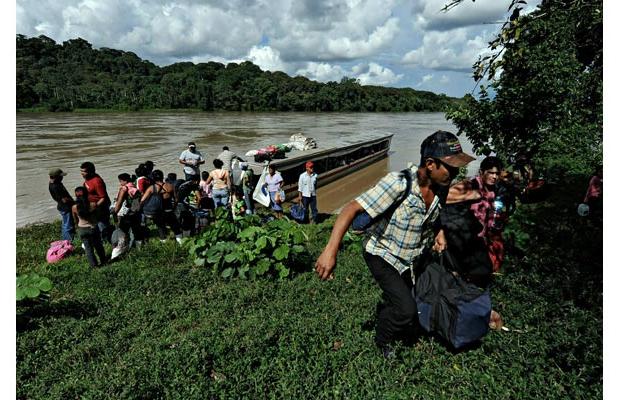 |
Nicaraguan immigrants arriving in Costa Rica |
Rica
via the San Juan River border. This immigration takes place for several
reasons but mostly is due to the political instability of Nicaragua and
the ease of illegal immigration into Costa Rica. This process is easy
for Nicaraguans because Costa Rica simply lacks the resources to control
the flow of people across the border. Since the 1970s, there has been a
nearly constant flow of illegal Nicaraguan immigrants which has become a
source of hostility from Costa Ricans towards Nicaraguans in the
region. Much of this xenophobic hostility stems from the widespread
stereotypes of Nicaraguans as violent and crime ridden. It also stems
from the increase in job competition that Nicaraguans bring to northern
Costa Rica. In the 1990's, public opinion in Costa Rica showed that 56%
of Costa Ricans opposed the presence of Nicaraguans in their country.
Again, the problem of illegal immigration is framed in nationalist terms
to grant legitimacy to the Costa Rican government and to provide
popular support for the regime. This creates an "us vs. them" mindset
between Costa Ricans and Nicaraguans which exacerbates border tension.
In addition to the
potential reasons for conflict stated above, it is predicted that some
of the most serious effects of climate change will be felt in Central
America and thus in this border region. Not only will extreme climatic
changes be felt here, but they will be felt very soon. Given the already
tense nature of the San Juan region and its role as an international
border, the coming effects of climate change such as drought, flooding,
and resource competition, will only exacerbate these tensions. It could
be the very spark needed to take this hostile political climate and set
it on fire.
3. Duration
Duration: Ongoing
The dispute between
Nicaragua and Costa Rica over the San Juan River began back in 1821
when they were both granted independence from Spain. Costa Rica annexed
two regions of Nicaragua, Nicoya and Guanacaste, shortly after
independence which changed the existing border. Finally in 1858 the
Canas-Jerez Treaty initiated a legal disagreement between the states.
The disagreement began over Costa Rica's rights to navigate the San
Juan, and has escalated to defining the actual location of the San Juan
River and potentially the resulting international border. This dispute
has extended into the 21st century where it came close to armed conflict
as recently as 2010, which classifies it as ongoing.
4. Location
The main location
of this dispute is the eastern portion of the border between Nicaragua
and Costa Rica to the east of Lake Nicaragua. This includes land regions
in Nicaragua from San Carlos in the West to San Juan Del Norte in the
East. And land regions in Costa Rica from Los Chiles to Colorado. The
chance of a conflict erupting that would involve the entirety of either
state is unlikely and thus the location is restricted to the border
region.
5. Actors
The actors involved in this dispute are:
- The inhabitants of the border region, both Costa Ricans and Nicaraguans
- The Costa Rican Government
- The Nicaraguan Government
Back To Top
II. ENVIRONMENTAL ASPECTS
6. Type of Environmental Problem
The basic
environmental problem is rapid climate change. Central America is
expected to have dramatic effects from the current rate of climate
change. Such effects include sea level rise, salinisation, extreme
drought, and extreme flooding. Unfortunately the predictions and
forecasting of such events is not much more specific. Different regions
may experience severe droughts while others suffer from intense flooding
but which effects will be felt in which region is not known. Despite
this uncertainty, the International Panel on Climate Change (IPCC) has
forecasted changes in both precipitation and temperature in this region
to the best of its ability. According to the IPCC's Fourth Assessment
Report relesed in 2007, Central America is supposed to experience
increases in temperature between 1 degree Celsius and 6.6 degrees
Celsius by the year 2080, depending on the season. Precipitation changes
by the year 2080 are predicted to be anywhere between a 30% decrease
and an 8% increase.
Change in Temperature (Cels.) |
|
2020 |
2050 |
2080 |
| Central America |
Dry Season |
+0.4 to +1.1 |
+1.0 to +3.0 |
+1.0 to +5.0 |
| |
Wet Season |
+0.5 to +1.7 |
+1.0 to +4.0 |
+1.3 to +6.6 |
Change in Precipitation (%) |
|
2020 |
2050 |
2080 |
| Central America |
Dry Season |
- 7 to + 7 |
- 12 to + 5 |
- 20 to + 8 |
| |
Wet Season |
- 10 to + 4 |
- 15 to + 3 |
- 30 to + 5 |
These forecasts by
the IPCC, which is considered the premiere climate change organization
today, illustrate the uncertainty surrounding climate change and its
effects in Central America. The temperature in Costa Rica and Nicaragua
will increase, it is only the scale of this increase that is not
certain. On the other hand, the San Juan River and its basin could be
receiving 30% less precipitation than it did in 2007 or as much as 8%
more. Yet since the temperature will obviously be increasing and the
forecast seems to favor decreased precipitation, the remainder of this
analysis will assume drought to be the most important obstacle in the
San Juan border region.
7. Type of Habitat
The habitat of both
Nicaragua and Costa Rica, as well as their shared border region, is
tropical. It has a wet season and a dry season like most tropical
habitats. Most of the land area around the border however, is
specifically forest. These forests feed off of the San Juan River and
drought could be potentially devastating.
8. Act and Harm Sites:
The act and harm
sites will be the San Juan River basin and civilian populations affected
by the severe droughts. These climate change induced environmental
changes will reduce the water supply to both Costa Rican and Nicaraguan
populations who rely on the San Juan River Basin. Populations in this
area will experience water scarcity and increased competition for
remaining water resources.
Back To Top
III. CONFLICT ASPECTS
9. Type of Conflict
Despite that fact
that this region is located in a potential "Hot War" zone regarding the
predicted effects of climate change, the conflict between Nicaragua and
Costa Rica over the San Juan River and resulting border has been kept
mostly in the political realm. The governments of each state have made
conflicting claims, condemned one anothers actions, and even sought
third party arbitration. This began with the United States and the
Cleveland award in 1881, as previously noted. However this political
conflict has manifested in third party arbitration much more recently as
well. In 2005, Costa Rica decided to give into the Nicaraguan
government by seeking a ruling at the International Court in The Hague.
The International Court's decision ,
10. Level of Conflict
Currently, the conflict remains dormant. No physical violence or clash of armed forces is occuring. But Central America,
and hence both Nicaragua and Costa Rica, is located in a potential "Hot
War" zone due to the predicted effects of climate change. This makes
the region more prone to potential conflict and very important to watch
in the future.
11. Fatality Level of Dispute (Military and Civilian fatalities)
No fatalities have
been reported due to the border dispute. While military personnel have
had been deployed, armed conflict has been avoided for at least the past
100 years. The majority of this dispute is non-violent.
Back To Top
IV. ENVIRONMENT AND CONFLICT OVERLAP
12. Environment-Conflict Link and Dynamics:
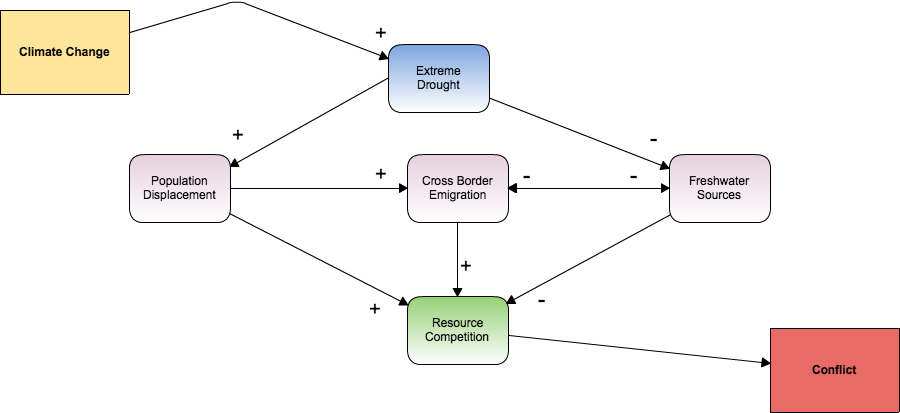
This causal loop
diagram shows the links between climate change and potential conflict
around the Nicaragua/Costa Rica border. Climate change in this region is
predicted to reduce precipitation, while also increasing temperatures.
Increased climate change, will cause increased cases of extreme drought.
This drought will in turn have two effects: to cause more population
displacement for people who can no longer live off of the land, and to
cause a reduction in freshwater resources. Both a loss of water source
and the population movement already in place will cause more Nicaraguans
to emigrate to Costa Rica since most of the San Juan is diverted into
Costa Rican territory. This movement of peoples could be legal but will
most likely be illegal given established patterns of immigration across
the border. Adding more people to the northern region of Costa Rica will
increase resource competition between already hostil groups. The Costa
Rican government could plausibly to crack down on Nicaraguan illegals to
the likely dismay of the Nicaraguan government. With national pride in
the way, and a valuable water resource at stake, conflict is likely to
erupt.
13. Level of Strategic Influence
In order to avoid
this outcome, the actions should come from the inter-governmental level.
The governments of both Nicaragua and Costa Rica need to stop defining
this border dispute in nationalist terms and instead work on
collaborative projects to protect the San Juan River and its basin from
climate change. The populations of each state would need to accept this
cooperation and also understand that their xenophobic tendencies only
make the problem worse. A
bilateral agreement and/or project, with the support of Nicaraguan and
Costa Rican citizens, to put aside differences and protect a valuable
resource could mitigate the chance of nationalist conflict.
Back To Top
V. RELATED INFORMATION AND SOURCES
15. Related ICE Cases
ICE Case 5 Peruecwar
ICE Case 32 Soccer
ICE Case 236 Aymara
16. Relevant Websites and Literature
- "San Juan River -- Border dispute between Costa Rica and Nicaragua"
http://www.geog.umd.edu/academic/undergrad/harper/Berrios.pdf
- "The Nicaragua-Costa Rica Border Dispute - A Symptom of 'Tico' Decline?
http://blogs.lse.ac.uk/ideas/2011/03/the-nicaragua-costa-rica-border-dispute-‚€“-a-symptom-of-‚€˜tico‚€™-decline/
- "The Rio San Juan: Source of Conflicts and Nationalism"
http://www.envio.org.ni/articulo/3112
- "Nicaragua's President Accuses Costa Rica of Trying to Steal Rio San Juan"
http://www.ticotimes.net/Current-Edition/News-Briefs/Nicaragua-s-President-Accuses-Costa-Rica-of-Trying-to-Steal-Rio-San-Juan_Tuesday-November-02-2010/(offset)/10
- "The Truths that Costa Rica Hides"
http://www.el19digital.com/documentos/TruthsCostaRicaHides_webVersion.pdf
- "Experience Nicaragua - History"
http://library.thinkquest.org/17749/history.html
- "The Political Formula of Costa Rica"
http://lanic.utexas.edu/project/etext/llilas/tpla/8801.pdf
- "Climate Change 2007: Working Group II: Impacts, Adaptation, and Vulnerability"
http://www.ipcc.ch/publications_and_data/ar4/wg2/en/ch13.html
- "Climate Change and the World's River Basins: Anticipating Management Options"
http://www.jstor.org.proxyau.wrlc.org/stable/20440816?
Back To Top
